|
|
Carolyn Wilki attended Cornell University and graduated cum laude from Bryn
Mawr College with a major in psychology. She has been herding since 1987, and
teaching and writing about herding since 1989. In 1992, her column So You'd
Like to Try Herding won the Maxwell Award for Best Column from the Dog
Writers Association of America. She trains all breeds of dogs, all herding
courses and all styles of herding at Raspberry Ridge and has instructed dogs
and owners to over 90 herding titles, including advanced titles and multiple
high in trial distinctions on a variety of herding courses. Carolyn conducts
herding instinct tests, seminars, clinics, herding demonstrations and private
lessons. Besides herding, Carolyn also provides obedience instruction and
counseling for difficult and aggressive dogs and their owners.
How I Got from There to Here...
Herding training is about building a relationship with your dog.
I have come to that conclusion through years of my own relationship-building
with my own German Shepherds and Border Collies. Consequently, I greatly prefer
training a handler and dog as a team. Most of the dogs I train are pet and
companion dogs. They are stuck with the owners they have. If I can help owner
and dog work more smoothly with each other so that each experiences greater
mutual pleasure, well, that makes my day! Herding work can be the ultimate,
pleasurable expression for a herding dog, the expression of what centuries of
breeding for that purpose has given that dog. However, anything I do with the
dog and owner ought to enhance the relationship that the owner and dog has so
that they can appreciate each other more fully in the other areas of their
shared lives.
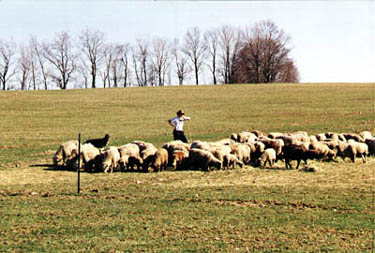 Without German-style tending and an AKC C Course, I don't think I would have
gotten as heavily involved as I am in herding or in dog training. Tending,
because it is a different type of livestock management system than what I had
first been introduced to as a novice herder, gave me the chance to develop a
deeper insight and respect for the different skills and strengths each dog
brings to the herding party. Tending taught me about the importance of focusing
on the relationship among the animals- the shepherd, the dog, the sheep- rather
than trying to master the mere technical aspects of each herding task. I think
I am a better person for having accepted this broader lesson.
Without German-style tending and an AKC C Course, I don't think I would have
gotten as heavily involved as I am in herding or in dog training. Tending,
because it is a different type of livestock management system than what I had
first been introduced to as a novice herder, gave me the chance to develop a
deeper insight and respect for the different skills and strengths each dog
brings to the herding party. Tending taught me about the importance of focusing
on the relationship among the animals- the shepherd, the dog, the sheep- rather
than trying to master the mere technical aspects of each herding task. I think
I am a better person for having accepted this broader lesson.
Let's begin at ground zero. I got my first German Shepherd Dog in 1983 when I
bought my first house. Muffin was an old, flea bitten dog living in the
backyard. Nobody else wanted her. How could I resist? Muffin had a heart
problem, was arthritic, and snored loudly, but she could still do things like
bark, watch, hike, swim, and "close the door"-- her cue to go to the door to
which I pointed and push & whack at it with her nose until the door closed
with a satisfying "click." Muffin hooked me on German Shepherds.
My second German Shepherd was Blondie, who in 1985 came from the same breeder
as old Muffin. Blondie was a ball of fire- very cute, very lively, a sidewalk
supervisor of all projects, in love with life, and especially tennis balls, and
I didn't know what to do with her to control her when I walked her to the park.
My ligaments in my shoulders were painfully yanked to shreds. So, I took
Blondie to obedience lessons at a training club back in the days when nobody
used food or toys to train dogs. I watched the others in the class yell at
their dogs, pop the leash, jerk the dog, and scream "Good Dog,"--and win at
obedience trials.
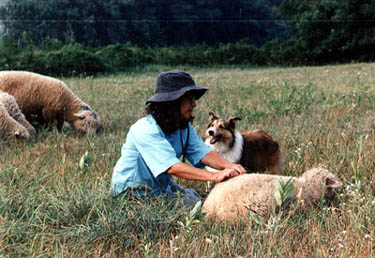 I confess that I was intimidated by all the harshness; on the other hand, the
thought of winning at obedience trials appealed to me. Therefore, I did my best
to ape everyone else in the club because they, after all, were experienced at
winning obedience trials. I yelled, popped, jerked, and had a miserable time
with Blondie as an obedience partner. I used to refer to obedience trials as my
weekly public humiliation sessions, good for my soul if not my ego. I got a
second, older German shepherd, named Sarah who fortunately loved obedience (she
was a little bit stupid, but sweet) which helped to salve my wounded feelings.
Sarah was also excellent company for Blondie because she allowed Blondie to
boss her around. Blondie most certainly was the difficult child. Little did I
realize at the time that her problem was me, the difficult owner.
I confess that I was intimidated by all the harshness; on the other hand, the
thought of winning at obedience trials appealed to me. Therefore, I did my best
to ape everyone else in the club because they, after all, were experienced at
winning obedience trials. I yelled, popped, jerked, and had a miserable time
with Blondie as an obedience partner. I used to refer to obedience trials as my
weekly public humiliation sessions, good for my soul if not my ego. I got a
second, older German shepherd, named Sarah who fortunately loved obedience (she
was a little bit stupid, but sweet) which helped to salve my wounded feelings.
Sarah was also excellent company for Blondie because she allowed Blondie to
boss her around. Blondie most certainly was the difficult child. Little did I
realize at the time that her problem was me, the difficult owner.
I began herding in 1987 (Blondie was 2 and Sarah was 6) because I wanted to
understand why "Shepherd" was in the name of the breed "German Shepherd Dog."
At the time I was thinking about obtaining yet more dogs and showing in the
conformation ring. However, I could not reconcile what I was seeing winning in
the breed ring with the breed standard I read in the book. Knowledgeable people
said I had to decide on the "type" of German Shepherd I liked. I decided the
type I should logically like was the type most suitable for shepherding,
whatever that type was. I endeavored to find out.
I took my dogs to a herding instinct test, which consisted of letting a dog run
after 3 sheep in a small arena supervised by a qualified trainer. The herding
trainer I was in touch with at the time told me to curtail obedience training
with my Blondie dog a couple of weeks before the herding instinct test. I
poo-pooed the suggestion because in one exposure to sheep two weeks before the
instinct test, Blondie had shown clear interest in chasing sheep. Silly city
slicker that I was, I continued to distraction-proof my Blondie dog in her
regular obedience training. The grand results were that my Sarah dog passed her
herding instinct test, but Blondie flunked while eating 3 pieces of sheep
doo-doo and easily sailing over a 42" fence out of the arena away from the
sheep and the test all within about 20 humiliating seconds.
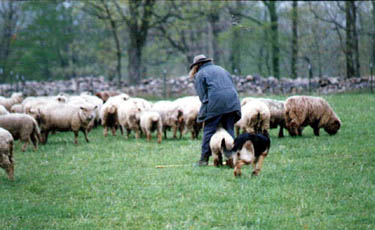 I didn't make the connection at the time, but Blondie probably outsmarted us
all by bidding adieu, simply because she thought she was being set up for
another obedience distraction with the sheep, and for a herding dog, sheep have
got to be the biggest, most attractive distraction of them all.
I didn't make the connection at the time, but Blondie probably outsmarted us
all by bidding adieu, simply because she thought she was being set up for
another obedience distraction with the sheep, and for a herding dog, sheep have
got to be the biggest, most attractive distraction of them all.
During the ensuing 6 months, I tied Blondie out under a picnic table once a
week to watch while I trained Sarah in herding fetching style. Sarah was eager
and kept close to the sheep when she was wearing behind them. However, my
normally very obedient and sedate Sarah was a little crazed when working sheep,
nipping at and pulling wool with a gleam in her eye. Sarah was not very
talented at herding, but neither was I.
Then, one day, Blondie barked at sheep. I didn't believe her. The next time
out, sure enough, she barked at sheep again. I let her loose on sheep. Blondie
was definitely interested in chasing them, but being a typical slow-footed
bi-ped, my foot speed was lacking! I simply could not keep up with my ballistic
dog and could not slow her down, and so, Blondie continued to do time watching
on the sidelines while I trained my slower and more controllable Sarah dog.
I remember participating in a group training session with Sarah one evening,
along with a Belgian Tervuren, a Smooth Collie, and their respective owners.
All of us had been working on the concept of outrun for 3 months, using all
sorts of prompts and aids to try to get our dogs to run wide of the stock. All
of us were fairly decent amateur trainers with normally intelligent dogs. Yet,
in waltzed a 6 month old Border Collie who had been working on the outrun for a
measly 3 weeks who literally ran rings around the rest of us and put our
progress to shame. Something was wrong with this picture! Then, my herding
instructor had me look at a German HGH tending competition film. We wondered
how in the world did the dogs get the sheep to move since they seemed to be
moving along the sides of the flock rather than behind.
 We received a little more information from Robie Kaman, Executive Director of
Fidelco Guide Dog Foundation in Connecticut, about this German HGH tending she
had actually seen in Germany. Robie flies to Germany on a regular basis to
purchase dogs for her guide dog program. She finds that using the bloodlines
from herding lines gives her the sort of service dog she is looking for, and
selects her dogs from Karl Fuller's Kirschental Kennels. Karl Fuller, besides
being a well-known breeder of German Shepherd Dogs, is also a professional
shepherd with a flock of 800 sheep.
We received a little more information from Robie Kaman, Executive Director of
Fidelco Guide Dog Foundation in Connecticut, about this German HGH tending she
had actually seen in Germany. Robie flies to Germany on a regular basis to
purchase dogs for her guide dog program. She finds that using the bloodlines
from herding lines gives her the sort of service dog she is looking for, and
selects her dogs from Karl Fuller's Kirschental Kennels. Karl Fuller, besides
being a well-known breeder of German Shepherd Dogs, is also a professional
shepherd with a flock of 800 sheep.
One evening, my herding trainer encouraged me to try Blondie tending some sheep
in a field using methodology that she and Robie developed. Blondie took to the
tending game immediately. I asked my trainer how well adapted Blondie was to
this herding style, on a scale from 1 to 10, ten being the top most. She said
Blondie was a 10! Blondie? The dog who botched everything else in her life (but
cutely)? Good at something besides retrieving tennis balls? Not Blondie! She
was so good that the next day during daylight, I videotaped the next hour of
work that Blondie did as she trampled her own 12 inch deep furrow in the mud
while patrolling her borders. Sarah was not interested in this style of
herding- if she couldn't be close to the sheep, she didn't want to work, plus
she simply didn't have the stamina nor breadth of focus to patrol the border
for an entire flock of sheep. She may have been simply too entrenched in the
fundamentals of fetching training to make the switch.
Another 6 months went by, and Robie graciously arranged for a group of us to
visit with Karl Fuller in Germany to watch him work his dogs with his 800 sheep
as he migrated them from northern to southern Germany for the winter graze. I
ended up going to Germany and France to see other trainers and competitions for
myself and to learn how to train tending dogs.
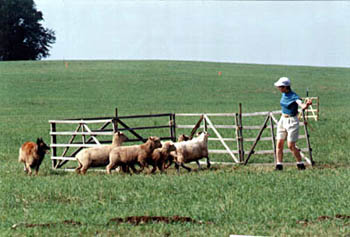 I visited a French shepherd to solicit her opinions about herding "issues." One
of the questions I had at the time was about the various herding styles of
dogs-- how do you categorize them? Border Collies seemed to herd differently
from German Shepherd Dogs, who work differently from Shelties, etc. Since this
woman had been shepherding for 20 years and since she herded with Border
Collies, Pyrenean Shepherd Dogs (not to be confused with Great Pyrenees),
Briards, and a Komondor when she took her flock of 1000 sheep up to the Alps
for 6 months every year, I thought she might have a multi-breed perspective of
interest. She did.
I visited a French shepherd to solicit her opinions about herding "issues." One
of the questions I had at the time was about the various herding styles of
dogs-- how do you categorize them? Border Collies seemed to herd differently
from German Shepherd Dogs, who work differently from Shelties, etc. Since this
woman had been shepherding for 20 years and since she herded with Border
Collies, Pyrenean Shepherd Dogs (not to be confused with Great Pyrenees),
Briards, and a Komondor when she took her flock of 1000 sheep up to the Alps
for 6 months every year, I thought she might have a multi-breed perspective of
interest. She did.
Rather than divide the dogs up into "heading" or "heeling" breeds, fetchers and
drivers, the French shepherdess suggested that the key to the difference among
the dogs was the nature of the relationship that the dog needed with its
shepherd. The Border Collie, she felt, had the most instinctual behavior - not
all of them, but the best needed little help from their masters. The BCs were
capable of working the furthest away from their shepherd without direction. The
tending Briard/German Shepherds, she felt, had a middle level of instinct,
performing some actions quite instinctually but needing an intermediate level
of help. They also worked an intermediate distance away from their shepherd.
The "foot dog" like her Pyrenean Shepherd Dog needed the most help of all,
quite willing to work the flock but needing her direction about how to do it. A
foot dog is so-called because it goes from the foot of the shepherd, performs
on command, and then returns to the foot to await yet another command.Yet with
all the help the little guy may have needed, at 9 months, the Pyr could fully
control the flock.
The weekly 4 hour trip to Connecticut for a herding lesson eventually grew very
old and very long. I wanted to work closer to home, but with German Shepherd
Dogs and an unfamiliar style of herding, try finding a flock of sheep to use! I
ended up growing my own large flock of sheep - I started with 5 - so that I
could practice tending specifically. Five became 50 became 100, became 200, all
because I like to stand around and watch sheep eat.
In my early years, I got myself into livestock management situations which
greatly benefited from tending management since I did not have enough of my own
land to fence in for pasture. The choices back then were feeding my flock year
round with hay and grain (expensive) or grazing my animals in nearby, unfenced
fields that I didn't own. I could spend hours and hours moving electric fence
and trying to put wiggly fiberglass fence poles into cement-hard clay soil
which was always heavily peppered with a bumper crop of baby boulders, or I
could spend hours and hours training and working my dogs to herd sheep and have
the dogs act as living fences while my sheep grazed. The choice was obvious to
me!
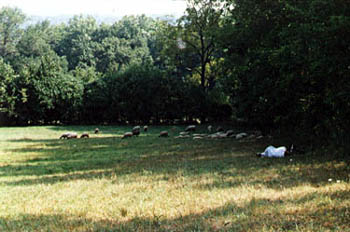 Through tending, much more so than through fetching/gathering training, I began
to feel like I understood my German Shepherd Dogs better. I had a definite,
clearer idea of what I wanted to see in my herding dogs, in terms of their
structure, temperament, instinctual behaviors, and training for different
tasks. I developed a strong appreciation for the strengths and talents of
herding dogs of other breeds as well.
Through tending, much more so than through fetching/gathering training, I began
to feel like I understood my German Shepherd Dogs better. I had a definite,
clearer idea of what I wanted to see in my herding dogs, in terms of their
structure, temperament, instinctual behaviors, and training for different
tasks. I developed a strong appreciation for the strengths and talents of
herding dogs of other breeds as well.
In the early years of tending, we learned things that probably no experienced
professional tending shepherd in Europe ever had to bother with, such as how to
condition flocks of sheep from scratch for tending management, how to set up
artificial boundaries in snow or with hay or lime chalk on a dry, flat field,
how to set up artificial lures outside the graze area for training purposes in
lieu of non-existent sugar beet fields, how to train companion pet dogs who
live without daily access to sheep to tend (not to mention how to train their
tenderfooted owners!), and how to deal with dog breeds in tending not
originally bred specifically for tending. We have also compiled impressive
historical evidence of tending throughout Western Europe and have come to
understand the differences between tending in France and tending in Germany,
not to mention Hungary.
When I was first asked to train other people's dogs for herding, it was with
Pulik. Eventually, I had a number of people who came to me with German
Shepherds and then with other breeds such as Shetland Sheepdogs, Collies,
Border Collies, Australian Shepherds, Belgian Sheepdogs, Corgis, Rottweilers,
Samoyeds, Catahoula Leopard Dogs, Briards, Pyrenean Shepherds, PONs, Bouviers,
Kelpies, Entlebuchers, Australian Cattle Dogs, etc. You name a breed of herding
dog, and I have probably worked with it or know something about it! I have even
worked with non-herding breeds such as Rhodesian Ridgebacks, Pointers, Poodles,
Chows, and various terriers, not to mention mixed breeds. I am willing to do
work with non-traditional herding breeds as far as they are able to go because
sometimes an owner is eager to learn about herding and that dog is all the
owner has.
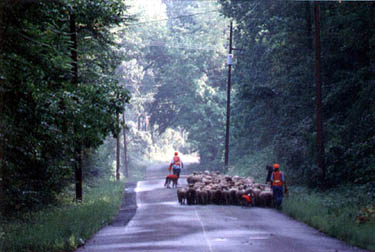 One of the things I noticed early on, was when I trained my dogs or watched my
students train their dogs, was the puzzling impact that punishment had on dogs
when they bit sheep. Roughly 50% of the dogs that were punished by their owners
would pee or leave the herding venue, done for the day. Roughly the other 50%
would immediately go back to biting the same or another sheep, often with more
force or gusto on the same or on another body part. The owners, who were often
experienced obedience trainers, would ask me, "What did I do wrong? How could I
have corrected any better? Was my timing off?" I had no answer because I
couldn't see how the owner could have grabbed, shaken, hit, or otherwise
corrected the dog any harder or faster than what I had witnessed. The 50% of
the dogs that were re-biting the sheep were not "vicious" in the way that the
term was normally used, but they sure as heck were beating up on my sheep!
One of the things I noticed early on, was when I trained my dogs or watched my
students train their dogs, was the puzzling impact that punishment had on dogs
when they bit sheep. Roughly 50% of the dogs that were punished by their owners
would pee or leave the herding venue, done for the day. Roughly the other 50%
would immediately go back to biting the same or another sheep, often with more
force or gusto on the same or on another body part. The owners, who were often
experienced obedience trainers, would ask me, "What did I do wrong? How could I
have corrected any better? Was my timing off?" I had no answer because I
couldn't see how the owner could have grabbed, shaken, hit, or otherwise
corrected the dog any harder or faster than what I had witnessed. The 50% of
the dogs that were re-biting the sheep were not "vicious" in the way that the
term was normally used, but they sure as heck were beating up on my sheep!
The striking variability in the dogs' responses led me back to my psychology
textbooks to find out what was going on. I actually read some books I had kept
but never read while I was in college! I also watched training tapes featuring
Ted Turner, the killer whale trainer from Seaworld (he is my hero).
I discovered that out in my sheep fields I was witnessing fundamental laws of
behavior:
-
that animals who are punished will predictably escape, avoid, or aggress to
cope with the punishment.
-
that aggressive strategies the animal pursues will be aimed at something the
animal perceives as being smaller and more vulnerable than itself.
-
that the escape, avoidance, or aggressive strategy that the animal pursues may
occur in an entirely different venue.
-
that punishment might indeed suppress one behavior, but that punishment gives
the trainer no absolute control over the next behavior the animal uses to
replace the suppressed behavior.
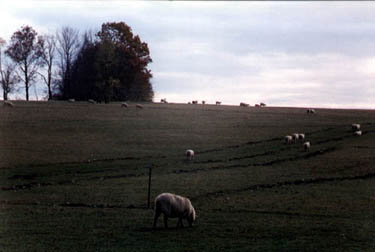 These fundamental truths about behavior, and others, which I was reading about,
were proven in the psychology research laboratories, had hundreds of thousands
of experimental hours behind them to buttress the conclusions, and explained
the daily happenings I was witnessing out in my sheep fields.
Empirically-based, behavioral psychology gave me a logical framework for
analyzing training problems and, more importantly, gave me a logical framework
for finding suitable training solutions. Listening to Ted Turner espouse these
same training principles while showing examples of marine animals trained at
Seaworld gave me the courage to try them out in my sheep fields. After all, if
the principles worked when training 8 ton animals to not eat species they
normally dined on in the wild, how could they not work on 20 to 80 pound
animals whom we were asking to herd (not chase or eat) sheep? I have since
tried to find techniques to train dogs and their people to herd that avoid
punishment. I have also expanded my training to other dog sport areas and to
help people with typical obedience problems. My years of expertise gained in
the sheep fields have also given me insight into dealing with difficult dog and
aggressive dog issues, and some of the most satisfying work I do nowadays
involves helping owners and their dogs to learn to behave more appropriately in
everyday life.
These fundamental truths about behavior, and others, which I was reading about,
were proven in the psychology research laboratories, had hundreds of thousands
of experimental hours behind them to buttress the conclusions, and explained
the daily happenings I was witnessing out in my sheep fields.
Empirically-based, behavioral psychology gave me a logical framework for
analyzing training problems and, more importantly, gave me a logical framework
for finding suitable training solutions. Listening to Ted Turner espouse these
same training principles while showing examples of marine animals trained at
Seaworld gave me the courage to try them out in my sheep fields. After all, if
the principles worked when training 8 ton animals to not eat species they
normally dined on in the wild, how could they not work on 20 to 80 pound
animals whom we were asking to herd (not chase or eat) sheep? I have since
tried to find techniques to train dogs and their people to herd that avoid
punishment. I have also expanded my training to other dog sport areas and to
help people with typical obedience problems. My years of expertise gained in
the sheep fields have also given me insight into dealing with difficult dog and
aggressive dog issues, and some of the most satisfying work I do nowadays
involves helping owners and their dogs to learn to behave more appropriately in
everyday life.
Besides my German Shepherds, I work and live with Border Collies. The two
breeds attract me because of their seemingly great need for a job (they want to
do something with you, the biped), high energy levels, their ease in training
(once you understand how to work with them), and their ease of daily care. I
favor the ones with short, easy to care for coats. Both breeds sport tails, and
I have an irrational need to live with dogs with tails. They are both very
natural breeds. The German Shepherds have been the loose-eyed "iron fists" on
the farm, while the Border Collies are the strong-eyed "velvet gloves." Nothing
beats a German Shepherd (remember, I am imprinted on German Shepherds!)
guarding sheep in an unfenced field or moving sheep down a road with busy
traffic vehicular traffic. On the other hand, nothing beats a Border Collie
when it comes to separating and holding, gathering strays, or moving a few
sheep away from the rest of the flock.
Although I take away and treasure something from each dog I train, my favorite
Border Collie so far has been "Dave," my smooth coated boyfriend from Scotland.
I had trained Border Collies previously, but Dave was the one who made me fall
in love with the breed. This year, because of drought, I have had no place to
graze sheep and so, my German Shepherd has been little used - on the other
hand, it has been a great time to train my Border Collies!
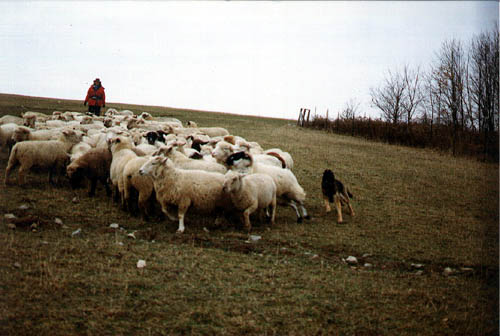 I lost
my Blondie dog to the ravages of old age, short of her 13th birthday. Right to
the end, as always, she did her best to be with the sheep. Blondie was a
special dog for me because she was the one who made me do all this-- learn
about tending, about fetching and driving, about dogs, about training, and get
sheep, then more sheep, more dogs, and a farm. She made me become the trainer I
am today. For some dogs, tennis balls are simply not enough! I lost
my Blondie dog to the ravages of old age, short of her 13th birthday. Right to
the end, as always, she did her best to be with the sheep. Blondie was a
special dog for me because she was the one who made me do all this-- learn
about tending, about fetching and driving, about dogs, about training, and get
sheep, then more sheep, more dogs, and a farm. She made me become the trainer I
am today. For some dogs, tennis balls are simply not enough!
|